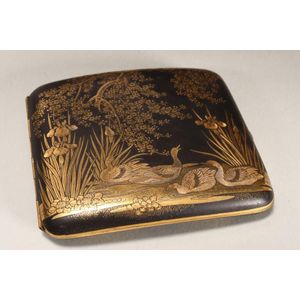Japanese Komai Damascene Cigarette Case, c.1920's
Japanese Komai damascene cigarette case, c.1920's, of rounded rectangular form, the hinged cover pleasantly decorated with water birds and irises below a blossoming tree, the verso with two peacock below blossoming branches and three character mark to lower left, further incised mark to gilt interior, 8 cm x 9 cm
You must be a subscriber, and be logged in to view price and dealer details.
Subscribe Now to view actual auction price for this item
When you subscribe, you have the option of setting the currency in which to display prices to $Au, $US, $NZ or Stg.
This item has been sold, and the description, image and price are for reference purposes only.
- Verso - Verso is the "back" side of a sheet of paper, art work, coin or medal. The front side is "recto".
- Incised - A record of a name, date or inscription, or a decoration scratched into a surface, usually of a glass or ceramic item with a blunt instrument to make a coarse indentation. Compare with engraving where the surface is cut with a sharp instrument such as a metal needle or rotating tool to achieve a fine indentation.
- Damascene - Damascening is a technique used to decorate metal objects, such as swords, armor, and other metalwork, by inlaying different colored metals into grooves that have been etched or engraved into the surface of the metal. The technique is believed to have originated in Damascus, Syria, and was later adopted by other cultures such as the Japanese, Indians and Iranians.
The process typically involves etching a design into the surface of the metal, and then filling the grooves with a contrasting metal, such as gold or silver. The inlaid metal is then burnished to create a smooth surface, and the design is polished to a high shine. Damascening can create intricate and highly detailed designs, and is often used to decorate weapons, as well as jewellery, and other decorative objects.
This item has been included into following indexes:
